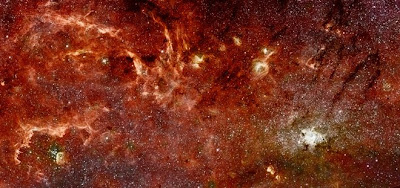 http://blog.wired.com/wiredscience/2009/01/milkyway.htm
http://blog.wired.com/wiredscience/2009/01/milkyway.htmMilky Way 50 Percent Larger, Astronomers Discover
By Alexis Madrigal
January 05, 2009
 Artist's conceptions of the Milky Way might give you the impression that astronomers have a precise notion of what our galaxy looks like, but you'd be wrong. In fact, new observations suggest that our home galaxy has been vastly underestimated.
Artist's conceptions of the Milky Way might give you the impression that astronomers have a precise notion of what our galaxy looks like, but you'd be wrong. In fact, new observations suggest that our home galaxy has been vastly underestimated.Those spiraling arms? Some scientists think it only has two, not four. Its size? For years, we thought that the Milky Way was substantially smaller than our closest galactic neighbor, the Andromeda Galaxy.
Now, new measurements of how quickly our galaxy is rotating have led a team of Harvard astrophysicists to conclude that our galaxy is 50 percent more massive than previously thought, and likely does have four arms.
"We should certainly think of the Milky Way no longer as the little sister of the local group," said Mark Reid of the Harvard-Smithsonian Center for Astrophysics. "We should think of the Milky Way and Andromeda as more like fraternal twins."
The question of what exactly our galaxy looks like is more difficult to solve than you might think. We're inside the galaxy, so we can't get direct perspective on our home. The best method is to measure how quickly the galaxy is rotating and back out to the amount of mass that would have to exist in the structure to generate that velocity.
Using the Very Large Baseline Array of radio telescopes, Reid's team found that the Milky Way is rotating at about 600,000 miles an hour, 100,000 miles per hour faster than previous estimates. When you do the math, that translates into the 50 percent mass increase his team reported in a press conference at the American Astronomical Society meeting Monday. One major consequence of a heavier Milky Way is that we're likely to collide with the Andromeda Galaxy sooner, Reid said.
The new measurements also seem to indicate that the galaxy must have the four arms that astronomers had long assumed before Spitzer Space Telescope observations last year called that into question.
"By measuring distances to regions of very massive star formation, we can start to trace out the spiral arms of the Milky Way and begin to constrain how tightly wound the arms are and trace out how many of them there are," Reid said.
With the new array of radio telescopes, the team has been able to make more precise measurements than ever before.
"We're using trigonometric parallax. It's essentially what surveyors do here on Earth," he said. "If you know the length of one leg of the triangle and the angles between the legs, you can calculate all the lengths."
In this case, they make an observation of the same region at two different times of the year, creating a triangle out of the earth's two positions and the star itself.
As for the discrepancy with the Spitzer's findings about the number of arms our galaxy has, Reid explained that he thought the old stars measured by the other group of astronomers only showed up in two of the arms, while his young stars showed up everywhere. Why only two of the galaxy's four arms would contain older stars would take further research into the galaxy's makeup.
"The central question here is: What does the Milky Way really look like?" Reid said.











No comments:
Post a Comment